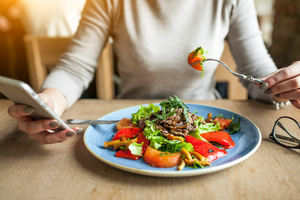Guilty pleasures...almost everyone has a few. It could be a glass of wine with dinner, bread and butter, a late-night bowl of ice cream with hot fudge topping, or a juicy steak with butter and a side of mashed potatoes and gravy. It is fine to have guilty pleasures occasionally, and sometimes there are healthier alternatives that can be satisfying without causing your blood sugar to spike. These are some ways to incorporate guilty food pleasures into your healthy diabetes meal plan without putting a damper on weight loss.
Being Selective
If you are going to have a guilty pleasure, you might as well make sure that it is truly a "pleasure." While everything may sound good, there may be only one or two items that you really, really want. A great example is at an all-you-can-eat buffet, where everything looks good at first glance, but it is worth the while to scour the options before selecting a single indulgence to enjoy. The same strategy works at parties, restaurants, supermarkets, and at home: what one treat do you really, really want, and which healthy foods will fill the rest of your plate?
Just a Bite or Two
A small helping can often be as satisfying as a large one, and far better for your waistline since "guilty pleasures" are usually high in calories and sugar or fat. For example, two double chocolate mini muffins can have 350 fewer calories than a single large one, a miniature-sized candy bar can have 300 calories less than a large one, a cup of mac and cheese can have 500 fewer calories than a whole plateful, and the smallest order of french fries can have 300 fewer calories than the largest.
These tips can make a small amount of a guilty pleasure go a long way.
- Take small bites and focus on the tastes and textures of each one.
- Satisfy hunger with nutritious foods, such as vegetables and lean proteins, before savoring that small serving of a guilty pleasure.
- Remember that tomorrow is another day, and you will have other opportunities to eat that treat, so there is no need to wolf it down or eat huge quantities now.
- Feel proud of yourself for being able to enjoy a guilty pleasure without letting it throw you off your healthy intentions.
Defining "Occasional"
An "occasional" treat may be okay, but "occasional" can easily turn into "regular" and then "frequent" without noticing. For example, a few drinks on Friday night with friends, waffles and bacon for Sunday brunch with family, cake at birthday parties and other celebrations, a weekly order of your favorite burger when having lunch out, and Monday morning croissants at the office are each reasonable, but end up being a treat nearly every day, and together adding about 2,000 calories - about half a pound's worth of fat - to each week.
Planning each treat in advance, and looking at all of them together, can give you perspective so you can see how much you are really having. Planning ahead can also help you adjust diabetes medications such as insulin to account for a higher amount of carbs, if necessary.
Convenience or Craving?
A treat can be worth the calories, and even help you stick to your diet, if you really, really want it, but what if you are just eating it because it is there? If you find yourself eating high-calorie foods, such as cookies, chips, and leftovers from restaurant meals, ask yourself if you really want them, or if you are just eating them because they are the quickest items? You may be happier, and almost certainly healthier, if you prepare healthy snacks that are more convenient to grab than less-healthy ones.
- Baby carrots, celery sticks, cucumber sticks, bell pepper strips
- Hard-boiled eggs, sliced cooked chicken breast
- Yogurt, cottage cheese
- Washed fruit, such as grapes, berries, apples, tangerines, oranges, cut melon
Treats have to be part of the plan if healthy eating is going to become a long-term habit, and if pounds are going to come off and stay off. The trick is to maximize satisfaction while fitting them into a nutritious diet to lose weight and improve health. Lark for Diabetes can help you stay on top of your diet and keep guilty pleasures in check as you continue to learn what works for you and your blood sugar.











.webp)








